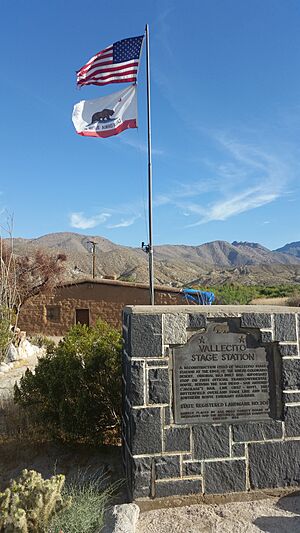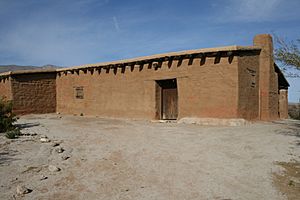Vallecito, San Diego County, California facts for kids
Quick facts for kids Vallecito |
|
|---|---|
| Vallecito Stage Station County Park | |

Vallecitos Stage Station historical marker (2017)
|
|
| Lua error in Module:Location_map at line 420: attempt to index field 'wikibase' (a nil value). | |
| Location | San Diego County, California, U.S. |
| Nearest city | Agua Caliente Springs, California |
| Operated by | San Diego County |
|
Former settlement
|
|
| Nickname(s):
Vallecitas
|
|
| Elevation | 474 m (1,555 ft) |
| Official name | Vallecito Stage Station |
| Reference no. | 304 |
Vallecito is a special place in San Diego County, California. It's like a green island, or oasis, in the dry Colorado Desert. Here, you can find wet, marshy areas called cienegas and special salt grass growing along Vallecito Creek. The name "Vallecito" means "little valley" in Spanish.
For a long time, this oasis was a home for the native Kumeyaay people. It was also a very important stop for travelers crossing the desert. People from Sonora and New Mexico on their way to California would rest here. Later, American soldiers, gold seekers (called 49ers), and people moving their animals to the goldfields used it too. It was a key spot on the Southern Emigrant Trail.
In 1850, the U.S. Army set up a camp here called Depot Vallecito. It started as a simple warehouse to supply Fort Yuma. Over time, it grew into a store, a stage station (where horse-drawn coaches would stop), and a ranch house. The original building eventually fell into ruin. But in 1934, it was rebuilt and is now part of the Vallecito Stage Station County Park.
This area has a rich history. There are old trails used by Native Americans from the Laguna Mountains. You can also find important Kumeyaay village sites. Vallecito was a famous stop on the Southern Overland Trail, a path used by many different groups of people for thousands of years. This includes Native Peoples, explorers, Mexicans, early U.S. military, mail carriers, pioneers in wagons, stage coaches, and gold-seekers.
Contents
A Look Back: Vallecito's History
Hawi: An Ancient Oasis
Long ago, the native Kumeyaay people had a seasonal village here called Hawi. It was located in the Vallecito Valley. This village was a vital link on a trail between the Quechan people near the Colorado River and the Kumeyaay living closer to the San Diego coast. After leaving Hawi, the trail went up Oriflamme Canyon to a place called Cañada Verde, or Green Valley, in the Cuyamaca Mountains. From there, it followed the Sweetwater River down to the coast. The Kumeyaay continued to use Hawi well into the 1800s.
In 1854-55, a report described the water at Vallecito:
The water at Vallecitas is hard and sulphurous, but not unpleasant to the taste. As many as twenty springs are concentrated near the camping ground; these ooze out gently, flow down a few yards as a small stream, and then sink into the soil.
The first European to visit Vallecito was Spanish Captain Pedro Fages in 1781. Because of its fresh water and green grass, Vallecito became a crucial resting spot for Spanish and later Mexican travelers. They would recover here after their difficult journey across the dry Colorado Desert.
In 1846, Colonel Stephen Watts Kearny and his soldiers, along with their scout Kit Carson, passed through Vallecito. Soon after, Lt. Colonel Philip St. George Cooke and the Mormon Battalion followed. They created the first wagon road across the Southwest into California. This road, known as Cooke's Wagon Road, went through Vallecito, then to Warner Pass, Santa Ysabel, and finally to San Diego.
Later, during the California Gold Rush, much of this road became part of the Southern Emigrant Trail. This trail was the main path for the Forty-Niners heading to California. It was also a major route for large groups of cattle and sheep being moved from Texas and New Mexico to the goldfields. The water and grass at Vallecito saved many animals that were desperate after crossing the desert. Many animals were moved along this route from 1849 until the late 1870s, when railroads reached Fort Yuma. However, some animals were still driven on this route as late as 1919.
Army Camp and Depot Vallecito
In November 1850, Captain Samuel P. Heintzelman of the U.S. Army sent soldiers to Vallecito Valley. Their job was to build a post with a warehouse. This would be a supply depot for an expedition Heintzelman was leading to set up a fort at the Yuma Crossing. This new fort would help protect the area from outlaws and hostile Native Americans. The soldiers built a camp and a simple one-room building made of sod (earth and grass) near a spring. This became the U. S. Army depot, helping to build and supply Fort Yuma.
After 1851, Fort Yuma also received supplies by sea through Robinson's Landing at the mouth of the Colorado River in Sonora, Mexico. From there, goods were brought overland to the fort. However, the Vallecito depot was still used until 1853. That year, a steamboat began operating on the Lower Colorado River, bringing cargo directly to the fort from the landing. With the steamboat, the Vallecito post was no longer needed by the Army, so it was abandoned.
Lassator's Ranch: A New Beginning
In 1854, a settler named James Ruler Lassator (whose name is spelled in different ways in old records) took over the old sod building of Depot Vallecito. He expanded it and lived there with his wife, Sarah, and his stepsons, Andrew and John Mulkins. The Lassators raised their children there, ran a store, and offered a camping spot for travelers crossing the Colorado Desert on the Southern Emigrant Trail.
Between 1854 and 1857, military messengers carrying mail between San Diego and Fort Yuma used the old Native American trail through Vallecito and Green Valley. In 1857, Lassator and his stepson John Mulkins also started a 160-acre ranch in Green Valley in the Cuyamaca Mountains, west of Vallecito. At this ranch, they raised animals and cut hay. They sold these animals and feed to travelers at Vallecito. Lassator's Green Valley ranch became another rest stop on the trail. It also became his home and the site for yearly rodeos after he was appointed a local judge.
Vallecito Stage Station: A Busy Stop
In 1857, Vallecito and Lassator's Green Valley ranch became official stops on the San Antonio-San Diego Mail Line. This mail line first used the old Native American route to San Diego, passing through places like Julian Sandoval's Ranch and Mission San Diego. Travelers who could ride mules might go through Oriflamme Canyon between Lassator's Green Valley ranch and Carrizo Creek Station. Those who stayed on the coaches took the Southern Emigrant Trail to Rancho Valle de San Felipe and Warner Pass. From Warner's Ranch, they followed the old wagon road to San Diego, passing through San Ysabel and San Pasqual.
When the Butterfield Overland Mail company took over the mail route, its path was changed to go north toward Los Angeles. However, Lassiter remained the agent in charge of Vallecito Stage Station. He also managed the stations at Palm Springs and Carrizo Springs.
Vallecito and other stations like it were "swing" stations. This meant they replaced tired horse teams with fresh ones. Most stations had just one keeper, called a hostler, who cared for the horses and helped change teams with the driver. Vallecito was different. It kept extra livestock for other desert stations, so it had two hostlers, a cook who provided meals, and a merchant living at the store. The main division station on this route was the next one north, at San Felipe Station.
In 1861, the Butterfield Overland Mail route closed down because of the American Civil War. No stage line ran on this route during the war. They didn't start again until 1867. But Lassator's station was still used as a camp and a place for the Union Army and other travelers to get water and let their animals graze while traveling to and from Arizona Territory. In 1863, James Lassator was killed while looking for gold in Arizona. His Vallecito ranch then became the property of his stepson, John Mulkins.
John Hart bought the old Vallecito Station shortly after Lassator's death and ran it with his wife. Several short-lived stage lines that ran from Los Angeles and San Bernardino to Arizona used Vallecito, as well as most of the other old overland mail stations. John Hart died in 1867 at the age of 31 and was buried in the station cemetery. He was buried next to a mysterious "Lady in White." She had been a female passenger on one of the old Butterfield Mail coaches who became very sick and died at the station overnight. Since no one knew her identity, but she had a white wedding dress, the station staff dressed her in it and buried her about 100 feet from the station.
A few months later, Hart's widow married John C. Wilson, a stage driver. Vallecito continued to be a station for other stage companies until 1877. That's when the railroad replaced stagecoaches for long-distance travel between California and Arizona. When the Southern Pacific Railroad was completed between Los Angeles and Yuma in 1877, it ended the widespread use of the Southern Emigrant Trail. Hart's widow left the station in the late 1870s.
Vallecito Ranches: New Owners
Charles Ayres, who used to be the postmaster at Warner's Ranch from 1870 to 1875, and his family settled at the abandoned Vallecito station. There, he raised cattle and mules. James E. Mason visited the area in 1878 on a trip to look for gold and decided to settle at Vallecito. He kept his cattle with Ayres' animals. In 1879, Mason officially claimed 160 acres of land, which included the stage station. He received the official ownership papers on November 1, 1884.
A year later, Charles Ayres left his wife and children. His wife, Jesusa Ayres, got a divorce in 1888. She then married James Mason. The couple then sold their Vallecito homestead to Christian F. Holland, who was Jesusa's divorce lawyer from San Diego. A few years later, Holland bought another 640 acres in the center of the valley. He rented these properties to local ranchers or cattle companies who used the area for winter grazing. Mason and his wife moved to the next valley, near some springs, to start another ranch. This area became known as Mason Valley. In 1931, Mason died and is now buried in the last of the three graves at Vallecito Stage Station Cemetery.
Vallecito County Park: A Historical Site Today
In 1934, Holland gave six acres of land, along with the old, run-down Vallecito stage station, to San Diego County. With money from the county and a state relief agency, a local rancher named Everett Campbell oversaw the rebuilding of the old stage station. Today, the 1934 rebuilt Butterfield Stage Station is the main feature of a 71-acre County Park.
Images for kids




